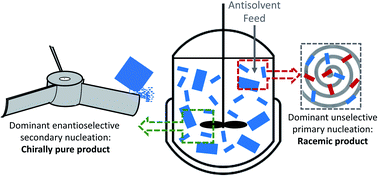The unexpected dominance of secondary over primary nucleation
Abstract
It is still a challenge to control the formation of particles in industrial crystallization processes. In such processes, new crystals can be generated either by primary or secondary nucleation. While in continuous stirred tank crystallization processes, secondary nucleation is thought to occur due to the shear or attrition of already present larger crystals; in antisolvent crystallization processes, where mixing at the inlets locally causes high supersaturations, primary nucleation is understood to be the main mechanism. We aim to show here that secondary nucleation is the dominant nucleation mechanism, even under conditions that are generally considered to be dominated by primary nucleation mechanisms. Measurements of primary and secondary nucleation rates under similar industrial crystallization conditions of sodium bromate in water, sodium chloride in water, glycine in water and isonicotinamide in ethanol show that the secondary nucleation rate is at least 6 orders of magnitude larger in all these systems. Furthermore, seeded fed-batch and continuous antisolvent crystallizations of sodium bromate under high local supersaturation, seeded with crystals of a specific handedness, result in a close to chirally pure crystalline product with the same handedness. This shows that indeed, enantioselective secondary nucleation is the dominant mechanism in these antisolvent crystallizations. It is even possible to use the enantioselective secondary nucleation mechanism to control the product chirality in such a process, making antisolvent crystallization a viable crystallization-enhanced deracemization technique, having a superior productivity compared to other crystallization-enhanced deracemization methods. Our finding of a dominant secondary nucleation mechanism, rather than primary nucleation, will have a strong impact on nucleation control strategies in industrial crystallization processes.

- This article is part of the themed collection: Understanding Crystallisation


 Please wait while we load your content...
Please wait while we load your content...